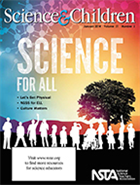Science for all
By Mary Bigelow
Posted on 2014-01-23
 This month’s guest editorials address the theme of science for ALL students:
This month’s guest editorials address the theme of science for ALL students:
- NGSS Case Studies: All Standards, All Students includes a table that highlights effective strategies for various demographic groups of students. The editorial also describes case studies that reflect the implementation of NGSS in real classrooms. These are worth a read. http://www.nextgenscience.org/appendix-d-case-studies
- Making a Difference describes some of the challenges of meeting the needs of all students in an elementary science class. Students with special needs or disabilities will need modifications to business as usual, and the article lists some research-supported effective practices such as adaptive materials for physically-challenged students, hands-on learning, well-designed heterogeneous grouping for cooperative activities.
For some of out students “hands-on” can be a challenge. The authors of Let’s Get Physical* show how they adapted two elementary science investigations (egg drop and plant growth) to include accommodations and suggestions for students with cognitive, physical, and sensory disabilities so they could fully participate. The suggestions could apply to any grade level and activity! [SciLinks: Learners with Disabilities]
Kindergarten students find out What’s the Weather Like Today?* with lesson ideas and strategies designed to reach students of all abilities. Focusing on wind patterns, students gather and chart data. Eventually they also collect and chart data on temperature and precipitation. The authors describe how the lesson uses trade books and can be adapted for students who use assistive technologies or have visual impairments. Watching the Wind* features several trade books and lessons that help children focus on what the wind can do so they can understand that wind has power and can be used to simply blow items around (K-2) or generate wind power through building windmills (3-5). The lessons include links online resources and connections to Common Core and [SciLinks: Winds, Weather]
Students come to our classrooms with varied experiences to build on: cultural backgrounds, ELL, reading level, learning preferences, age, and a range of abilities. Assessment for All discusses how formative assessment probes can address all students and ways teachers can adapt them to meet the diverse needs within their own classrooms.
Watching the Wind* features several trade books and lessons that help children focus on what the wind can do so they can understand that wind has power and can be used to simply blow items around (K-2) or generate wind power through building windmills (3-5). The lessons include links online resources and connections to Common Core and [SciLinks: Winds]
NGSS for English Language Learners* addresses the question of how to get ELL students to engage in scientific argumentation. When a lesson did not go as intended, the authors revised their thinking with reflection on NGSS goals, planning and practice in designing a lesson on forest ecosystems.
Most teachers appreciated the role of visualization in learning. The authors of The Power of Multimodal Representations* share research findings on the effectiveness of visual supports with students with learning disabilities and with emotional or behavioral disorders. They provide several examples of concept maps and student-generated drawings and photographs. The article also includes a template for a claims-and-evidence discussion
Do you have a family night or similar event for students and parents? The authors of Culture Matters in Science Education* describe a multicultural “festival” that engaged students, parents, and the community. The article also discusses the concept of “culturally relevant teaching” in terms of the diverse ethnic, cultural, linguistic, and religious backgrounds of students.
Using the school yard as a resource and building on their prior experiences, students investigated renewable and nonrenewable resources as described in Learning Science in Cultural Context*.
This month’s Early Years column, Shape Exploration: Another Dimension* has suggestions for young scientists to explore three-dimensional shapes.
*And check out more Connections or this issue (January 2014). Even if the article does not quite fit with your lesson agenda, there are ideas for handouts, background information sheets, data sheets, rubrics, and other resources.
Disclaimer: The views expressed in this blog post are those of the author(s) and do not necessarily reflect the official position of the National Science Teaching Association (NSTA).

